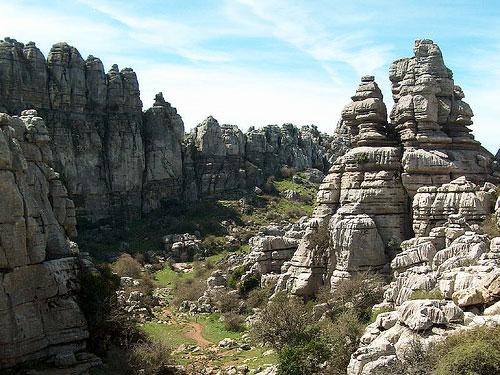Huelva is the most westerly of the Andalusian capitals. It is not as famous as other cities in Andalucía but, nevertheless, it has a long history and some splendid monuments to its rich heritage.
Phoenicians, Carthaginians, Romans and Moors are just some of the peoples who have populated this historic town. Then in 1257, Alfonso X the Wise of Castile recaptured Huelva for the Christians. However, the most significant historical event for the people of Huelva was the discovery of America. It was from this area of Spain that Christopher Columbus undertook the first of his voyages to the New World in 1492.
 |
| Huelva - Parque de las Palmeras - public domain |
The Avenida Andalucía is the main artery of Huelva situated in the modern part of the city. It is a pleasant place to stroll with its parks and gardens. The main green space in the city, though, is El Conquero, an area of green hills with delightful views. Nearby is Parque Moret another attractive green area with fruit trees and water features. On the northernmost edge of El Conquero is the Santuario de Nuestra Señora de la Cinta. This 15th century church has been declared a site of Cultural Interest. It was here that Columbus allegedly prayed after returning from his first trip to the Americas.
 |
| Catedral de la Merced © Robert Bovington |
There are many other religious buildings in Huelva. One of the most important is the Cathedral of La Merced, which began life as a church - the Convent of La Merced was constructed in 1605. It was converted to a cathedral in 1953. It also has been declared a site of Cultural Interest.
Just south of the cathedral is the historic part of the city, an area of narrow pedestrian streets located on both sides of Avenida Martin Alonso Pinzón. There are many beautiful buildings here including the neoclassical Town Hall and the Convento de las Agustinas de Santa María de Gracia. The latter is a bit of a mouthful but is a delightful convent with a Mudéjar courtyard. |
| Ayuntamiento Huelva - public domain |
Not only did Carthaginians, Romans and Moors populate this city but also the British! Huelva has had a long mining tradition and, in the 19th century, British mining companies established themselves in the city. In the Barrio Reina Victoria area of the city there are some grand old English style houses - worth a visit for any of you Brits who are homesick!
 |
| English-style houses in Huelva - public domain |
Huelva is the fourth largest port in Spain. Near the port is the Columbus Monument, which was built in 1929 by the North American Columbus Foundation.
more blogs by Robert Bovington...
"Photographs of
| |
"postcards from
| |
"you couldn't make it up!"
| |
"a grumpy old man in
| |
"bits and bobs"
| |
"Spanish Expressions"
| |
"Spanish Art"
| |
"Books About
|
www.tablondeanuncios.com













